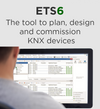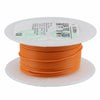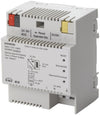- Your one stop shop for KNX devices in the USA 🇺🇸
- (+1) 786 956 6821
- support@knxsupply.com
- Store Location
- Sign in or Register
- Home
-
Categories
- System Devices
- Switching/Shutter Actuators
- Dimming Actuators
- HVAC
- Binary Inputs
- Keypads
- Gateways
- Enclosures and Boxes
- Occupancy Sensors
- Visualization Systems and Touch Panels
- Weather Sensors
- Drivers and ECGs
- Special Sensors
- HVAC
- Accessories
- Cable
- Expert Picks
- KNX Certified Training
- Newest Products
- Best Selling Products
Brands
- Articles
- Contact Us
- Home
- All Collections
- Switching/Shutter Actuators
Switching/Shutter Actuators
Bi-stable coupling relay for KNX Multi IO.
Application area
The Multi IO Extension Switch 590 serves as a power-saving alternative to commercial standard coupling relays.
The coupling relay is controlled as a mono-stable relay, but uses a bi-stable relay internally, thus reducing the holding current by up to 95%.
The Multi IO Extension Switch 590 has an integrated fuse to protect high-quality equipment.
KNX IP Multi IO with 48 configurable In- and Outputs.
Application area
The KNX IP Multi IO 580 is a universal binary interface for building control.
It provides 48 I/O lines.
Each line can be used as binary input as well as binary output.
The peripherals can be fed by an external voltage of 24 V⎓.
Channels which are configured as inputs can be used to control lights or blinds via the KNX network.
They also can be used to count impulses, e.g. as interface for energy meters.
Channels which are configured as outputs can directly drive signal LEDs, external coupling relays (e.g.
590) or jalousie relays (592).
The device works using the medium KNX IP.
It can be configured using the ETS (Version 4.2 or higher) with native parameters and standard group objects.
Also the KNX addressing scheme, based on individual device
address and group objects, is unchanged.
An easy to read OLED display on the front panel enables a manual operation to test the installation.
KNX TP Multi IO with 48 configurable In- and Outputs.
Application area
The KNX TP Multi IO 570 is a universal binary interface for building control.
It provides 48 I/O lines.
Each line can be used as binary input as well as binary output.
The peripherals can be fed by an external voltage of 24 V⎓.
Channels which are configured as inputs can be used to control lights or blinds via the KNX network.
They also can be used to count impulses, e.g. as interface for energy meters.
Channels which are configured as outputs can directly drive signal LEDs, external coupling relays (e.g.590) or jalousie relays (592).
The integrated USB interface allows establishing a bidirectional connection between a PC and the KNX bus.
The USB connector has a galvanic separation from the KNX bus.
Both ETS (Version 4.2 or later) and visualization tools support this interface.
The configuration of the device is done with ETS, a local download is possible.
An easy to read OLED display on the front panel enables a manual operation to test the installation.
Switching actuator with 1 output and 2 binary inputs.
Application area
The KNX IO 532 (1D1O) is a compact combined dimming/switching actuator with 1 PWM dimming output for LEDs and 1 bi-stable relay output.
The dimming actuator can be used e.g. for LED panels or stripes.
Besides controlling the dimmer by switching, rel.
Dimming and dimming value, several optional functions are integrated, including scenes, automatic, slumber function or staircase light.
The switching actuator provides the function for universal outputs including scene control, timer, staircase lighting and heating valves (PWM for thermoelectric valve drives).
Two push buttons and three LEDs allow a local operation and a visualization of the device state.
In addition to the output channels the device includes 16 independent functions for logic or timer control.
Universal dimming actuator and binary inputs with 1 230V dimming output for lights and 2 binary inputs.
Application area
The KNX IO 530 (1D2I) is a compact 230 V dimmer with 1 dimming output and 2 binary inputs.
The dimming actuator can be used for dimmable electric lights supplied with 230 V mains.
To cover a wide range of usable electric lights the KNX IO 530 can operate with trailing or leading edge dimming.
Besides controlling the light by switching, rel.
Dimming and dimming value, several optional functions are integrated, including scenes, automatic, slumber function, staircase light and sequencer.
Blind actuator with 2 binary inputs.
Application area
The KNX IO 520 (1J2I) is a compact blind actuator with two additional binary inputs.
The actuator is used to control a blind, a shutter or a window drive.
The relay contacts are electrically interlocked.
The inputs can be connected to conventional switches with an external voltage of 12 to 230 V.
In the not configured state the binary inputs control the actuator channel.
Via commissioning the device using ETS® software the binary inputs can be used independently.
Two push buttons and three LEDs allow a local operation and a visualization of the device state.
In addition to the output and input channels the device includes 16 independent functions for logic or timer control.
Switching actuator with 1 output and 2 binary inputs.
Application area
The KNX IO 511.1 secure (1O2I) is a compact switching actuator with 1 bi-stable output and 2 binary inputs.
The actuator provides the function for universal outputs including scene control, timer, staircase lighting and heating valves (PWM for thermoelectric valve drives).
The inputs can be connected to conventional switches with an external voltage of 12 to 230 V.
In ex-factory settings the inputs are connected internally to the actuator.
The actuator combined with input B1 serves as a latching relay.
Input B2 is used for zero crossing detection.
Switching actuator with 2 outputs.
Application area
The KNX IO 510.1 secure (2O) is a compact switching actuator with 2 bi-stable relay outputs.
The actuator provides the function for universal outputs including scene control, timer, staircase lightning and to control heating valves (PWM for thermoelectric valve drives).
Two push buttons and three LEDs allow a local operation and a visualization of the device state.
In addition to the output channels the device includes 16 independent functions for logic or timer control.
The device supports KNX Data Security.






























